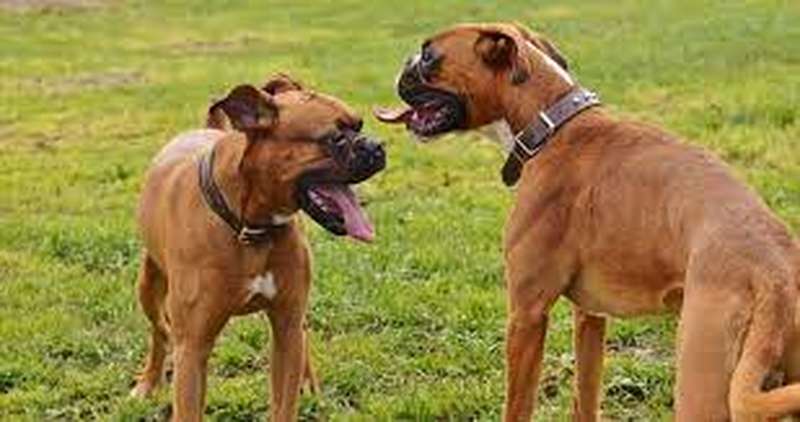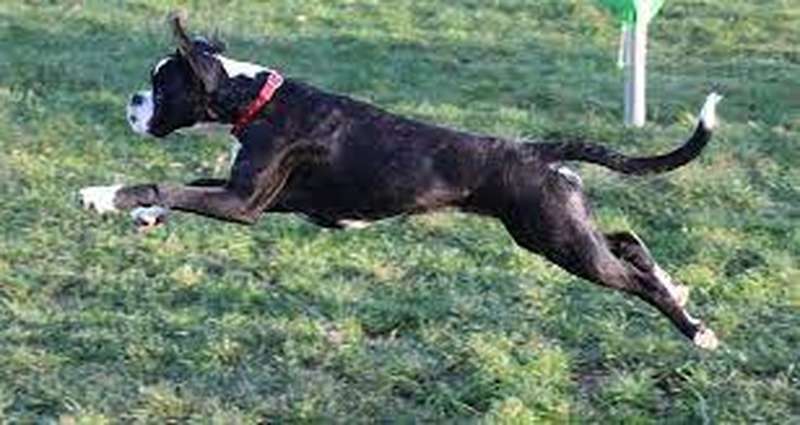Aggression is not often a problem with Boxers, unlike other breeds. This does not imply that all Boxers will behave in a composed manner at all times. Given that they were bred to fight, hunt, and serve as guard dogs, boxers have the genetic predisposition to be aggressive.
Are Boxers Aggressive?

Boxers are incredibly adorable dogs that are known for being excellent pets. They have a reputation for being highly loyal, although this loyalty can occasionally manifest as aggression.
If you have concerns about your Boxer potentially displaying aggression or if you have already noticed signs of aggression, there are steps you can take to address and correct this behavior. By doing so, you can help your Boxer become a loving and well-behaved pet.
Can boxers exhibit aggressive behavior?
Boxers have the potential to display aggression, but when purchased from a reputable breeder and given appropriate upbringing, socialization, and training, their likelihood of exhibiting aggressive behavior decreases significantly.
Aggression can be a result of past negative experiences, lack of exercise, and feeling threatened. However, it is important to note that these issues can be easily corrected.
If you are considering getting a Boxer and are concerned about their potential for aggression, continue reading to learn more.
What makes boxers so prone to violence?
Boxers can exhibit aggression due to their inherent breed-specific instincts. It is not something that is learned but rather something that is innate and developed over time.
Boxers can also exhibit aggression if they have not received proper socialization during their puppyhood. Boxers may fear the unknown due to limited exposure to the world, including interactions with other animals and people.
They display aggression towards other animals and people due to their uncertainty and fear. Boxers are known for their strong will and independent nature.
They possess a determined mindset and are not afraid to act independently. Boxers require owners who are confident, capable of taking charge of the animal, and committed to proper training and maintaining control at all times.

It is important to be aware that thyroid problems can sometimes contribute to aggression. It is important to have your dog examined by a veterinarian if it displays aggression in order to eliminate any potential medical issues.
10 Situations That Could Lead to Boxer Aggression
Although most Boxers are not naturally aggressive, certain situations can trigger aggression in them.
Lack of proper breeding
Certain dogs are bred from animals that exhibit aggression or possess genetic traits that increase their likelihood of being aggressive. Certain health problems can increase the likelihood of aggression in Boxers.
Not Being Socialised
Dogs that have not received proper socialization with people, children, or animals may exhibit aggression due to fear or territorial behavior.
Insufficient training
Certain dogs require training to manage their aggression and to develop appropriate behavior in various situations and with unfamiliar individuals. Improper training of a Boxer can lead to aggression toward unfamiliar situations and people.
Insufficient Daily Exercise
Boxers require ample exercise to maintain their well-being. Without sufficient physical activity, they may experience boredom, anxiety, and depression, potentially leading to aggressive behavior.
Territorial and dominance issues
Certain dogs can be territorial or exhibit dominant behavior. Dogs may exhibit guarding behavior towards their toys, bed, and even people. They may also experience issues with food aggression.
This issue is commonly referred to as resource guarding and can occur as a natural response in certain dogs or develop over time due to inadequate care.
An unneutered male.

Males tend to exhibit aggression more than females, particularly if they have not been neutered. Neutering boxers that display signs of aggression leads to a decrease in their aggression levels.
Past trauma or negative experiences
Dogs that have experienced abuse or trauma in the past may exhibit aggression in situations that trigger memories of those negative experiences.
Aggression between females
Female Boxers can exhibit aggression in the presence of other females. This is particularly true when the female dog is in heat, has puppies, or is pregnant.
The nature of being overly protective.
Boxers are known for being guard dogs and have a natural tendency to be overprotective. Aggression can sometimes manifest when individuals perceive a threat to themselves or their family.
The dog has a high prey drive.
Because of their high prey drive, boxers may view smaller dogs, cats, and other animals as prey and act aggressively toward them. Resolving this problem usually requires proper training.
How to Prevent Aggression in Boxers
If your Boxer is displaying signs of aggression, it is essential to intervene as soon as possible. By doing so, you increase the likelihood of stopping the behavior before it escalates. Here are some helpful tips.
One should establish a safe place.
Ensure that your dog feels secure and protected. Fear and confusion can often lead to aggression in many dogs.
When your dog begins to display signs of aggression, it is important to speak to him in a calm and soothing manner. This approach will help to divert his attention and promote a sense of calmness.
Utilize positive reinforcement techniques.
It is not advisable to punish your dog for displaying aggression. Instead, redirect the individual and provide positive reinforcement to help them remain calm. It is important to let them know that their calm behavior is appreciated and rewarded.
Please schedule a health check.
Dogs may exhibit aggressive behavior when they are experiencing pain, discomfort, or facing emotional and mental challenges.
Schedule an appointment with your veterinarian to have a health issue diagnosed or treated.
Encourage them to socialize.
Socialization is crucial for all dog breeds, and Boxers, in particular, benefit greatly from it. It is important to ensure that your dog receives ample socialization with other pets, animals, and people.
Advice from Experts
If you are unable to manage your dog’s aggression effectively, it may be advisable to consider seeking professional assistance.
You can locate trainers who specialize in addressing aggressive behavior and can assist you in correcting it.
Instead of facing the expenses of a lawsuit resulting from your dog’s attack on someone, it is advisable to invest in hiring a professional. This decision will prove to be a wise use of your money.
Is it advisable to have a boxer’s ears cropped?
Boxers typically have naturally floppy ears that fold over, but some owners choose to have them cropped. This process involves trimming the ears in a way that makes them point directly upwards.
While this activity is prohibited in numerous countries, it is generally permitted in the majority of the United States, albeit subject to regulation in certain states.
The decision to do this involves considering aesthetic, practical, and moral factors.
The Boxer: A Dedicated Working Dog
According to the American Kennel Club, boxers are classified as working dogs, whereas the United Kennel Club considers them to be guardian dogs. This breed is not limited to being a family pet only; it is also trained and utilized in various other roles.
Police Dogs:
Boxers are highly regarded as one of the preferred breeds for police work. They possess exceptional focus and are highly proficient in conducting drug searches.
They can also be trained to respond to threats by attacking and targeting criminals upon command.
War Dogs:
Boxers have a rich history of being utilized in military operations and are among the breeds employed by the U.S. Army.
Their high intelligence, adaptability, and athleticism make them extremely valuable. Boxers are excellent sentries due to their protective nature and inherent aggression.
In addition, they are highly skilled in detecting explosives and performing search and rescue missions.
Service Dogs :
Boxers are frequently chosen as seeing-eye dogs for individuals with visual impairments because of their intelligence and obedience, which are enhanced through proper training. They can also be used to assist individuals with other disabilities.
Therapy Dogs:
Highly trained boxers are occasionally utilized as therapy dogs in various settings such as schools, hospitals, hospices, retirement homes, and venues.
The Boxer breed has been a versatile and accomplished dog in various roles throughout history. When employed as a police or military dog, this breed demonstrates its bravery and formidable attack capabilities.
In November 1946, two British military Boxer dogs named Punch and Judy were honored with gallantry medals for their exceptional service.
The dogs heroically saved the lives of two officers stationed in Israel by preventing an assassination attack. Upon identifying the assailant, the Boxers courageously launched an attack, sustaining severe injuries.
However, their valiant efforts successfully protected their fellow soldiers.
It is crucial to remember that Boxers employed in these roles are consistently trained to be highly obedient. Expert handlers have trained these Boxers to bite and attack but only do so when commanded.
Issues can arise with Boxer dogs when their owners need more experience or are careless in providing the necessary training, guidance, and care.
Boxers’ Different Forms of Violence
Aggression is not always inappropriate. You can count on your Boxer to firmly protect your home.
If there is an intruder or when a family member is endangered, you might want him to be able to defend them.
He might even need to be able to defend himself in the event of an attack.
Your Boxer is the last thing you want.
- Fighting in the dog park (whether the dog park is an appropriate place for your Boxer to be is a different discussion)
- Any form of hostility towards others who are not a threat
- A lack of understanding of what constitutes a threat, or
- Disregarding your orders after being provoked to anger.
Other forms of aggression, some of which are partially innate canine instincts, need to be carefully controlled. Examples include:
- Aggressive eating or resource protection
- Territoriality
Conclusion
To ensure that Boxers are non-aggressive, this is essential for the owner to dedicate themselves to daily socialization and training sessions throughout the dog’s lifetime.
The key factor in the Boxer’s acceptance of and non-aggression towards people and other animals is the respectful and loving relationship between the Boxer and its owner.
The owner should assume the role of the pack leader, displaying qualities such as firmness, love, consistency, and control at all times.